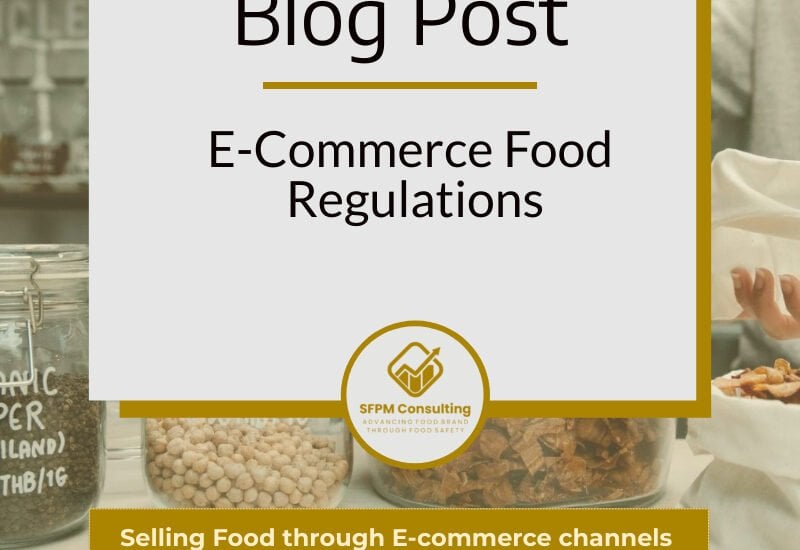E-Commerce Food Regulations
- June 24, 2021
- Posted by: Felicia L
- Categories: Food Safety, Start-Up

E-commerce Outlook
Many industries have been affected due to the COVID-19 Pandemic and as a result, E-commerce is booming. COVID-19 has contributed to an increased number of people staying at home. Thus, generating multiple opportunities for e-commerce based services including:
- Food delivery – Services such as Uber Eats, DoorDash, and Skip the Dishes that deliver ready-to-eat food from your favourite restaurants to your home or preferred destination.
- Grocery delivery – The use of services such as Uber Grocery and Instacart to place grocery orders and have them delivered to your home. Delivery of groceries at your doorstep may include fresh produce to ready-to-eat food.
- Meal Delivery Kits – Services such as HelloFresh and Chef’s Plate that deliver ready-to-cook meal kits that consist of pre-portioned produce, meats, or sauces blends. The meal delivery kits allow for you to have the right proportion of foods that is ready to cook, and get the home-cooked food atmosphere.
- E-trading – Selling of food through websites such as Shopify either through the manufacturer/distributors website or third-party website.
Selling food through e-commerce channel and platforms have its own food safety regulations and challenges especially if your businesses also involves import and export. In this article, we share the food safety regulations that you MUST know when you are starting or working on an e-commerce food business.
E-Commerce Food Regulations
E-Commerce Regulations in Canada

Here is what you must know. All products sold online in Canada must follow the same health and safety guidelines as food sold in stores. Selling a product online doesn’t exempt the seller from meeting the food safety and labelling requirements.
If you are working with importing and exporting food, do take the extra step to ensure that the products are approved to be sold at the intended country of sale. Just because a product can be sold in Canada, doesn’t mean that it meets the US requirements and vice versa.
- If you are considering selling food online, the Government of Canada recommends that you:
- Check food regulations that apply to your product
- Check the Automated Import Reference System (AIRS) for import regulations.
- Obtain a license for the product being exported where required. CFIA has an interactive tool that you may use to determine if you need an SFC license for importing and exporting activities, linked here: https://ca1se.voxco.com/SE/93/SFCR_licence/?&lang=en
- For more information on which activities require an SFC license and how to obtain a license refer to previous blogs linked here
Importing Food to the United States
If you are looking to import food to the US in your e-commerce food business, you should refer to FDA guidelines.
A few of the main guidelines include:
- Prior Notice is required before you send the food to the US. The food products must be accompanied by the Prior Notice when they are sent. You can file a Prior Notice using these instructions: https://www.fda.gov/food/importing-food-products-united-states/filing-prior-notice
- You may import food to the US without sanction from the FDA as long as the facilities producing, storing, and/or handling the items are registered with the FDA along with filing a prior notice.
- Baked goods, canned and packaged products, candy, as well as seafood must be labelled with information including the country of origin, ingredients, and nutrition facts.
Food Regulations for Mobile Food Delivery & Meal Delivery Kits
As we have discussed above, all food must meet the local requirements for food safety.
For mobile food delivery and meal kits, you must consider how to keep food safe. This typically includes considerations for
- Keeping hot food at a holding temperature of > 60 degrees Celcius
- Keeping cold food at a temperature of < 4 degrees Celcius
- Time taken for the delivery and consumption
- Instructions for consumers on how to keep food safe
- Consumer food safety education
- Cleanliness of the reusable delivery bags and containers
- Policy for the delivery services that you engage with
The food preparation areas must be an approved food production facilities by the local food authorities.
Tips for Selling Food through E-Commerce
Tips for Selling Food through E-Commerce
If you’re starting your food business and plan to use e-commerce, here are a few tips and things to consider before you start!
- Know the regulations relating to what you are selling. As previously stated, the food safety regulations in Canada are the same for online storefronts as it is in a normal one but importing and exporting can be tricky.
- Additionally, if you plan to sell in another country, know the food safety regulations of your product in that country too.
-
If you are just starting out, selling within your own country or province, maybe the best options until you are familiar or getting used to the country that you are planning to export to. The local food safety consultant and/or trading broker may be able to assist you with the requirements and regulations.
Bonus! Start-Up Ideas
Products with Minimal Regulations for Starting E-commerce Food Businesses
For those looking to start an e-commerce food business but not sure what to sell, here are some ideas from Shopify’s Ultimate Guide to Starting an Online Food Business, that are low-investment products that typically have minimal legal requirements may include:
- Candy
- Canned or packaged products
- Raw ingredients
- Coffee and tea
Key Take Away
While e-commerce has gain popularity with the new way of doing business during a global pandemic, it is very important to note that there are rules and regulations that must be followed when selling food products online. If you are working on product import and/or export, additional regulations may apply to you. Please check the required regulations through our resources link or contacting your local food safety consultant and a broker.
References /Resources
Canada, G. A. (2021, March 11). Guide: Spotlight on E-commerce. GAC. https://www.tradecommissioner.gc.ca/guides/spotlight-pleins_feux/guide_E-commerce-guide_commerce_electronique.aspx?lang=eng#a5.
Center for Food Safety and Applied Nutrition. (n.d.). Importing Food Products into the United States. U.S. Food and Drug Administration. https://www.fda.gov/food/food-imports-exports/importing-food-products-united-states.
Center for Food Safety and Applied Nutrition. (n.d.). Prior Notice of Imported Foods. U.S. Food and Drug Administration. https://www.fda.gov/food/importing-food-products-united-states/prior-notice-imported-foods.
Importing Food for Commercial Use. CBP Customer Service. (n.d.). https://help.cbp.gov/s/article/Article-83?language=en_US.
Winter, D. (2020, April 20). How to Start an Online Food Business: The Ultimate Guide. Shopify. https://www.shopify.ca/blog/213396233-how-to-start-a-food-business.
Share on Social Media
1 Comment
Comments are closed.

[…] E-commerce food businesses may have different regulations than food businesses following traditional models. To learn more about possible regulations for your food business, refer to our blog about e-commerce food businesses. […]